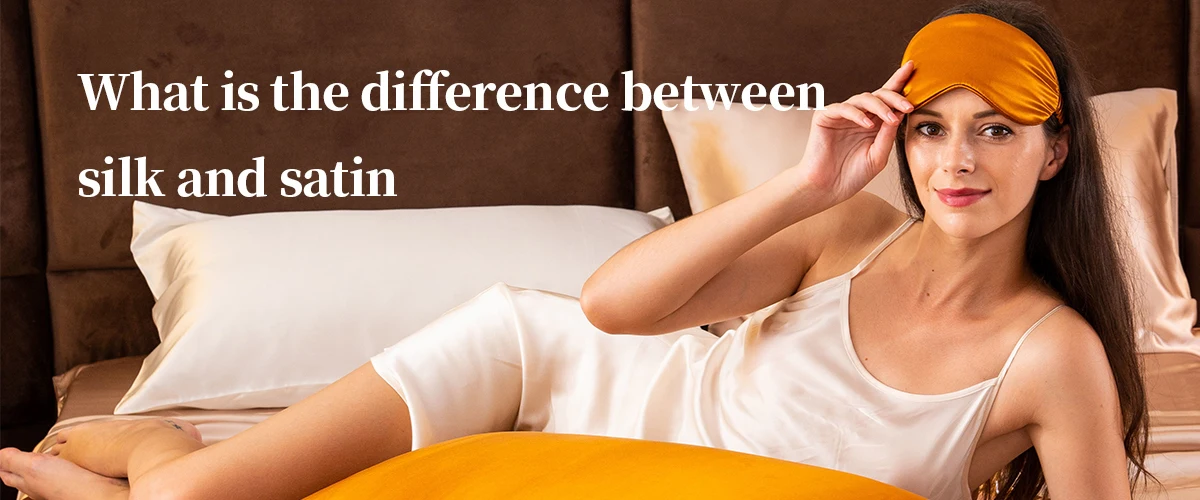What is the difference between silk and satin
The feel of sleeping on silk is like skin soaked in milk, silky and dense. Silk pillowcases, silk pajamas, silk sheets, etc. are selected as the best anniversary gifts for various anniversaries. Because silk is very classy and also has various good effects. Then when selecting products you may find that searching for silk products will bring up satin collections, which tend to be much cheaper than silk and look similar in terms of pictures.
Is silk or satin the same? Obviously, then, there must be a difference between silk and satin, otherwise, why would the price difference be so large? We asked professional fabric expert Andrew and dermatologist Cheryl Timothy to break down the differences between silk and satin, and which is best for your skin and sleep. Read on to see what they had to say.
What Is Silk?
Silk is a general term for mulberry silk, crushed silk, castor silk, cassava silk, and other types of silk. Silk is known as the Queen of Fibers and has been favored by people throughout history for its distinct beauty. Silk, a protein fiber, contains 18 different amino acids that are beneficial to the human body and can assist the skin in maintaining the metabolism of the surface lipid film, keeping the skin moist and smooth.
The Characteristics of Silk
Silk feels soft and flowing, a good gloss, silk is used to weave a protein-based fiber. Is treated as a natural silk protein, the beauty of a good product, but the price is more expensive. But the disadvantage is that the fabric is easy to age, easy to fade, and easy to wrinkle.
What Is Satin? Are satin and silk the same thing?
Satin material belongs to the silk fabric, smooth and lustrous, it also belongs to the satin or cotton satin fabric, just different materials, the softness of the section is not the same, 100% pure natural silk is very soft, and not easy to pilling. The silk and satin process is different, satin adds a chemical fiber material that is easy to pill.
The Characteristics of Satin
The advantage of satin is the atmosphere is gorgeous and smooth, and soft fabrics can increase the sense of magnificence, today's satin fabrics are not so expensive, especially for summer, and autumn.
The disadvantage of satin is that it is easy to draw silk, so this fabric must be well cared for, do not touch sharp objects, once the draw silk will not be able to recover, so satin products are rarely printed or embroidered elements, the purpose is also to better protect the satin.
Silk vs Stain: What's the difference between silk and satin?
| Silk | Stain |
| Silk is a natural fabric | Stain is a synthetic fabric |
| Expensive | Cheap |
| Luxury feeling | Silky feeling |
| Strong fabric | Less strong |
| Hand-wanshing is better | Can be machine-washed |
| Hard to maintain | Easy to maintain |
In addition to distinguishing between the concepts and characteristics of silk and satin, there are many other aspects of the two that need to be differentiated. This natural paragraph will explore what exactly is the difference between silk and satin from the following four aspects.
- The smoothness is different
Satin silk is generally light, silk is not light. Satin is synthetic, so the luster of satin is better than silk, but the touch of silk is more luxurious. Because of the scarcity, the price of silk than synthetic satin is more expensive
- Different treatment
Silk is rich in 18 kinds of amino acids and proteins thereby having a good nutritional effect on the human body; the correct washing and maintenance of silk clothing are very important, otherwise it will affect the life of silk clothing wear.
Silk should not be washed with an alkaline detergent or soap. It is best to use a small amount of neutral detergent.
Like any luxury material, satin requires special care to maintain its integrity and value. Considering that satin is made by a weaving technique, determining which fibers your item is made of is critical to clean the item without causing damage. But satin can be let into the washing machine for direct cleaning.
- Different uses
Silk is thin, and generally used to do pajamas or summer bedding (advanced silk fabrics are also used to do clothing) but easy wrinkle satin fabric is thicker and more used to do the cover of the winter cotton jacket or quilt cover (now rarely used).
- Different functions
Silk, which is a protein fiber, contains 18 kinds of amino acids that are beneficial to the human body and can help the skin maintain the metabolism of the surface lipid film, so it can keep the skin moist and smooth. So silk has a cosmetic effect on your hair and skin.
Satin is synthetic, so there is no cosmetic effect, but it has the same silky texture and shiny
Buying silk or satin, Which One Is Better?
Our fabric expert recommends using whatever works best for your sleeping situation and hair texture, type, and length, and she personally prefers using a silk pillowcase because it has a double benefit for her face skin. They believe that silk is better for all hair types, but especially curly and textured hair, because it adds an extra layer of protection.
In the end, whether satin or silk is better for your hair is determined by how well you sleep. Choose the price and texture that works best for you, whether it's silk or satin.


